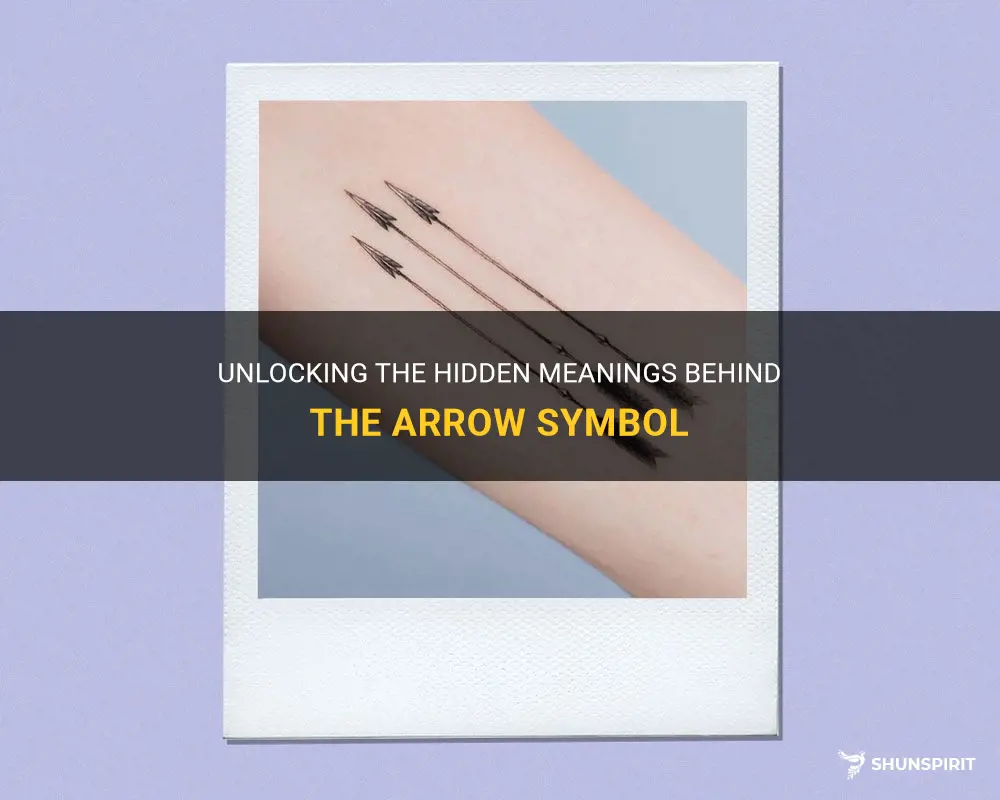
The arrow symbol has long been a powerful and evocative image, transcending cultural boundaries and language barriers. From the ancient Greeks using arrows to represent direction and purpose, to modern society utilizing arrows as a visual shorthand for progress and advancement, this simple icon carries an immense array of meanings. Symbolizing everything from determination and movement forward to protection and guidance, the arrow symbol has become a universal language of communication and understanding. Whether found in ancient cave drawings or contemporary logos, the arrow symbol continues to captivate and communicate profound messages to people of all backgrounds and beliefs.
What You'll Learn
- What is the symbolic meaning of an arrow symbol?
- In what cultures or religions does the arrow symbol hold significance and what is its meaning in those contexts?
- How has the meaning of the arrow symbol evolved throughout history?
- Are there any notable examples or stories where the arrow symbol is used to convey a specific message or idea?
- Can the direction in which an arrow symbol is pointing change its meaning, and if so, what are the different interpretations for different directions?

What is the symbolic meaning of an arrow symbol?
The arrow symbol is a powerful and meaningful design element that has been used throughout history in various cultures and contexts. Symbolically, the arrow represents different concepts and ideas depending on the culture and situation. In this article, we will explore the symbolic meaning of an arrow symbol.
One of the most common interpretations of an arrow symbol is direction and movement. Arrows have long been used as a wayfinding tool, indicating a path or direction. In this sense, an arrow can represent guidance, progress, and focus. It can symbolize moving forward, challenging oneself, and achieving goals. The arrow encourages individuals to stay focused on their desired direction and take the necessary steps to reach their destination.
Another symbolic meaning of an arrow symbol is protection. Historically, arrows were used as weapons for hunting and warfare. In many cultures, the arrow was seen as a tool to protect oneself and one's community. As a symbol, the arrow can represent strength, resilience, and the ability to defend against threats. It embodies the idea of being prepared and ready to face challenges and obstacles that may come one's way.
The arrow symbol is also associated with speed and swiftness. Arrows are known for their impressive speed and accuracy when shot from a bow. In this context, the arrow represents quickness, agility, and efficiency. It embodies the idea of being swift in decision-making and action-taking. The arrow symbolizes the ability to adapt and respond quickly to changes or opportunities that arise.
Furthermore, the arrow symbol can have a more personal and introspective meaning. In this context, the arrow represents self-discovery, purpose, and personal growth. It symbolizes the journey of self-reflection and transformation. The arrow encourages individuals to look within, explore their passions and interests, and follow their true path in life. It signifies the importance of finding one's purpose and living a meaningful and fulfilling life.
In Native American cultures, arrows hold significant spiritual meanings. They are often seen as symbols of prayer, protection, and blessings. Arrows are believed to carry positive energy and can be used as spiritual tools for healing and connecting with the divine. In this context, the arrow symbolizes the connection between the physical and spiritual realms.
In conclusion, the arrow symbol carries multiple symbolic meanings depending on the cultural and situational context. It represents direction, movement, protection, speed, self-discovery, and spirituality. As a powerful and versatile symbol, the arrow has been used throughout history to convey these concepts and inspire individuals to follow their path, overcome challenges, and live with purpose.
The Symbolic Meaning Behind BTS: Decoding the Hidden Messages in their Iconic Logo
You may want to see also

In what cultures or religions does the arrow symbol hold significance and what is its meaning in those contexts?
In various cultures and religions around the world, the arrow symbol holds great significance and carries different meanings. From ancient civilizations to modern-day practices, the arrow has been used as a powerful symbol of strength, direction, and protection.
In Native American cultures, the arrow symbolizes protection and defense. It represents the ability to ward off evil spirits and protect oneself against harm. For Native American tribes such as the Navajo and Apache, arrows are considered sacred objects that represent spiritual energy and the connection between humans and the divine. The arrowhead, in particular, is seen as a powerful talisman that brings good luck and wards off negative energy.
In Norse mythology, the arrow symbolizes strength and power. Valhalla, the mythical afterlife for fallen warriors, is said to be entered through a gate guarded by a towering wall of arrows. The arrowheads serve as weapons of defense and are also used in divination to seek guidance from the gods. The arrow was often associated with the god Odin, who was known as the god of war and wisdom.
In Hinduism, the arrow symbolizes the divine weapon wielded by Lord Rama, an avatar of Lord Vishnu. Lord Rama's bow and arrow represent righteousness, protection, and the ability to destroy evil forces. The arrow is seen as a powerful instrument that brings justice and restores balance in the world. This symbolism is further reinforced by the Hindu goddess Durga, who carries a bow and arrow as her weapons to vanquish demons and protect her devotees.
In Chinese culture, the arrow symbolizes the pursuit of goals and ambitions. It represents determination and the ability to overcome obstacles. The Chinese proverb "箭在弦上,不得不发" (jiàn zài xián shàng, bù dé bù fā) translates to "the arrow is on the string, it must be shot." This proverb signifies the importance of taking action and seizing opportunities. In Chinese weddings, the bride and groom often exchange arrows as a symbol of their commitment to supporting and protecting each other.
In Christianity, the arrow symbolizes the power of the Holy Spirit. In the Bible, the arrows of God are described as arrows of truth that strike down the enemy. The passage in Psalms 127:4 states, "Like arrows in the hands of a warrior, so are children born in one's youth." This verse emphasizes the importance of raising children as arrows in the hands of their parents, ready to be guided and directed in the ways of righteousness.
In conclusion, the arrow symbol holds great significance in various cultures and religions. From protection and defense in Native American cultures to strength and power in Norse mythology, the arrow symbolizes different virtues and qualities. Whether it represents determination in Chinese culture or the power of the Holy Spirit in Christianity, the arrow serves as a powerful reminder of strength, direction, and protection in different contexts.
The Rich Symbolism and Deep Meanings of Hmong Symbols
You may want to see also

How has the meaning of the arrow symbol evolved throughout history?
Throughout history, the arrow symbol has held various meanings and connotations. From its early origins as a weapon of war to its modern-day symbolism in technology and communication, the arrow has evolved to represent different concepts and ideas.
In ancient times, the arrow was primarily seen as a weapon used for hunting and warfare. It was a symbol of power, strength, and dominance. The ability to accurately shoot an arrow was a highly valued skill, and those who excelled at it were often held in high regard.
In many cultures, the arrow also represented direction and guidance. It was used as a tool for navigation, as it could be shot into the air and used as a point of reference. This idea of the arrow pointing the way later became associated with guidance and leadership.
As societies progressed and became more complex, the arrow took on new meanings. In Greek mythology, for example, the god Apollo was often depicted carrying a bow and arrow. The arrow was seen as a symbol of divine intervention and the power to control fate.
In the Middle Ages, the arrow symbol took on a religious significance. It became associated with St. Sebastian, who was known as the patron saint of archers. The arrow was seen as a metaphor for the suffering and martyrdom of St. Sebastian.
In modern times, the arrow symbol has taken on a new meaning in the realm of technology and communication. With the rise of the internet and digital media, the arrow has become a common symbol for navigation and linking. It is often used as a graphical representation of a hyperlink, indicating that clicking on it will take the user to another location or page.
The arrow symbol is also commonly used in logos and branding. Companies such as Amazon, FedEx, and Nike have incorporated arrows into their logos, symbolizing forward motion, speed, and progress.
In popular culture, the arrow has become associated with the superhero character Green Arrow. He is known for his archery skills and the use of arrows as his primary weapon. The arrow has become a symbol of justice, heroism, and vigilante justice.
Overall, the meaning of the arrow symbol has evolved throughout history. From its origins as a weapon of war and navigation to its modern-day association with technology and communication, the arrow has come to represent a wide range of concepts and ideas.
The Power and Wisdom Behind Reiki Symbols: Unveiling Their Meanings
You may want to see also

Are there any notable examples or stories where the arrow symbol is used to convey a specific message or idea?
Arrow symbols have been used extensively throughout history to convey various messages and ideas. From ancient civilizations to modern-day societies, arrows have played a significant role in visual communication. Here are some notable examples and stories where the arrow symbol is used to convey specific messages or ideas.
Native American Culture:
In Native American cultures, arrows were used to symbolize direction and guidance. Tribes often incorporated arrow symbols into their art, clothing, and tattoo designs to represent the path one should take in life. It was believed that arrows provided protection and pointed individuals towards their true calling.
Archery and Warfare:
Arrows have long been associated with archery and warfare. In medieval times, archers used arrows as their primary weapon, and arrowheads were crafted to inflict maximum damage. During battles, the direction in which arrows were shot could convey specific strategies or messages to the opposing side. For example, a barrage of arrows raining down from above indicated an aerial attack.
Symbol of Love:
The arrow symbol has also been associated with love and romance. In Roman mythology, Cupid, the god of desire, was depicted as a young boy with wings and a bow and arrow. Legend has it that Cupid's arrows had the power to make people fall in love with the first person they saw. This iconic representation of love has been widely adopted in modern culture, particularly around Valentine's Day.
Road Signs:
In modern society, arrow symbols are commonly seen on road signs to provide directions and indicate turns. These signs are essential for maintaining safety and ensuring smooth traffic flow. Arrows point drivers in the right direction and help them make informed decisions while navigating roads and highways.
User Interface Design:
In the digital age, arrow symbols have become an integral part of user interface design. They are used to indicate navigation, such as going back or forward in a web browser. Arrows are also employed to guide users' attention towards specific elements or actions. For example, a right-pointing arrow may prompt users to click on a button or explore further options.
Significance in Art and Design:
Arrows often find their way into various forms of art and design. Graphic designers and illustrators frequently incorporate arrow symbols in logos, posters, and other visual compositions. These symbols can represent progression, movement, or a specific direction, depending on the context. Arrows add dynamism and visually guide the viewer's eye within the artwork.
Environmental Signage:
In recent years, arrow symbols have been used in environmental signage systems to convey sustainable practices. For example, a recycling symbol may incorporate an arrow to indicate the cycle of materials and encourage proper waste management. These icons help raise awareness about environmental issues and promote eco-friendly behavior.
Overall, the arrow symbol has been used in diverse contexts to convey specific messages and ideas. Whether representing direction, love, or functionality, arrows have proven to be a universal and versatile symbol throughout history and continue to play an essential role in visual communication.
Unlocking the Symbolic Meaning of the Wolf
You may want to see also

Can the direction in which an arrow symbol is pointing change its meaning, and if so, what are the different interpretations for different directions?
Arrows have been used as symbols for centuries, and their meanings can vary depending on the direction in which they are pointing. The direction of an arrow can often communicate a specific message or evoke certain emotions. In this article, we will explore how the meaning of an arrow can change based on its direction and discuss the different interpretations for different directions.
Arrow pointing upwards:
When an arrow is pointing upwards, it typically represents progress, growth, and positivity. This direction is commonly associated with success, achievement, and improvement. It can be seen as a symbol of moving forward and reaching new heights. An upward-pointing arrow can also represent hope, inspiration, and a focus on the future.
Arrow pointing downwards:
On the other hand, when an arrow is pointing downwards, it generally signifies descent, decline, or negativity. This direction is often associated with loss, failure, and a decrease in value or quality. It can be interpreted as a symbol of going backward or experiencing a downfall. A downward-pointing arrow can also represent sadness, melancholy, or a sense of disappointment.
Arrow pointing to the left:
When an arrow is pointing to the left, it can represent the past, nostalgia, or reflection. This direction is often associated with memories, looking back, or a journey into the past. It can be interpreted as a symbol of change, transformation, or moving away from the present. A left-pointing arrow can also evoke a sense of nostalgia or serve as a reminder of previous experiences.
Arrow pointing to the right:
Conversely, an arrow pointing to the right usually signifies the future, progress, or forward movement. This direction is often associated with planning, goal-setting, or a focus on what lies ahead. It can be interpreted as a symbol of direction, determination, and taking action. A right-pointing arrow can also symbolize adventure, curiosity, or a desire for new experiences.
Arrow pointing in multiple directions:
Sometimes an arrow can point in multiple directions or form a circle, such as in a recycling symbol. This represents the concept of cycle, renewal, or continuous movement. It can be interpreted as a symbol of sustainability, harmony, or a reminder that everything is interconnected. Arrows pointing in different directions can also symbolize flexibility, adaptability, or the need to consider multiple paths.
Overall, the direction in which an arrow is pointing can indeed change its meaning. An upward arrow can symbolize progress and positivity, while a downward arrow may represent decline or negativity. A left-pointing arrow can evoke nostalgia or reflection, while a right-pointing arrow signifies forward movement and planning. Arrows pointing in multiple directions represent cycles or interconnectedness. Understanding the different interpretations for different directions can enhance our understanding and communication when using arrow symbols.
Decoding the Map Symbols in Life360: Understanding the Meaning Behind Every Icon
You may want to see also
Frequently asked questions
The arrow symbol is often used to represent direction or movement. It can symbolize progress, growth, or a forward-thinking mindset.
An upward arrow typically symbolizes progress, growth, or improvement. It can be used to represent positive change or advancement in various contexts.
A downward arrow can symbolize a decrease, decline, or regression. It can indicate a negative change or a decrease in value or quantity.
A right-facing arrow symbolizes forward movement or progress in a specific direction. It can represent the idea of moving forward or following a specific path.
A left-facing arrow symbolizes backward movement or going against the norm. It can represent the idea of turning back or deviating from the expected path.







